

October 05, 2023
Rebeka MeszarosYou don’t have to be a data scientist to make sense of Facebook analytics. This guide breaks it down for you, turning what might seem like digital gibberish into a clear roadmap for action. You’ll learn how to sift through your Facebook data to find the insights that matter most. Knowing how to read your Facebook analytics report is essential whether you’re already savvy in social media management or just getting started. It’s not just about collecting data; it’s about using it to make smarter decisions and achieve real results. Let’s get started, shall we?
It’s the powerhouse behind your Facebook business page, turning raw data into actionable insights. Far from being just a collection of numbers and charts, Facebook analytics gives you a comprehensive look at how your audience interacts with your brand. It tracks everything from who visits your page and engages with your posts to the overall performance of your Facebook campaigns. You’ll get audience demographics, page views, engagement rates and more metrics. These insights help you understand what’s resonating with your audience and what needs tweaking. For example, if you notice video posts getting more engagement than text updates, that’s a clear signal to produce more video content. In essence, Facebook analytics serves as your go-to resource for evaluating the success of your Facebook marketing efforts. For a more complete picture, you can pair Facebook Analytics with Google Analytics. Our guide on Measuring Success with Google Analytics can help you understand how to integrate these two powerful tools. Google Analytics can track user behavior on your website, providing a fuller understanding of how your social media efforts translate into website visits and conversions. For a comprehensive view of how to elevate your social media marketing prowess, read this Social Media Marketing Guide.
Understanding Facebook analytics becomes much easier when you’re familiar with the specialized tools available. Each platform has its own set of features designed to help you navigate your analytics journey more effectively. Let’s look at Facebook’s core offerings:
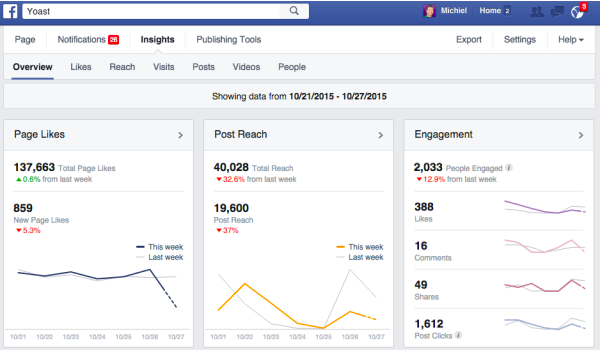
Facebook Insights is your foundational tool, providing a snapshot of your page’s key performance indicators like page likes, post reach and engagement rate. It’s essentially your go-to dashboard for understanding how your page is performing. Key features:
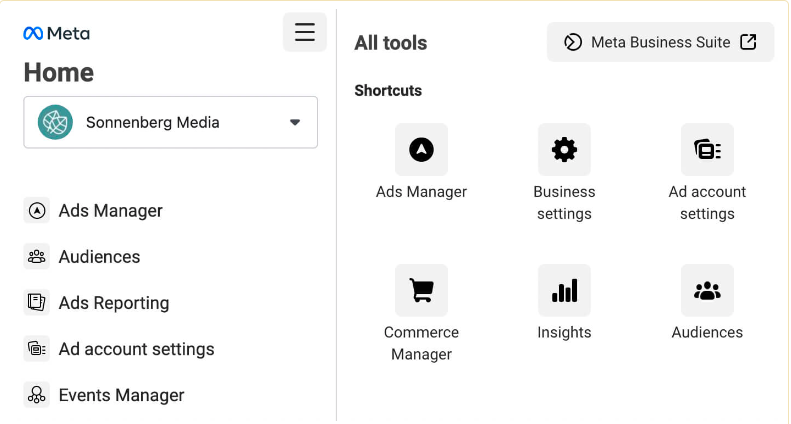
Meta Business Suite is more than just a stand-in for Facebook’s discontinued native analytics tool. It offers a comprehensive marketing dashboard that tracks your Facebook metrics and integrates data from other platforms like Instagram.
Key features:
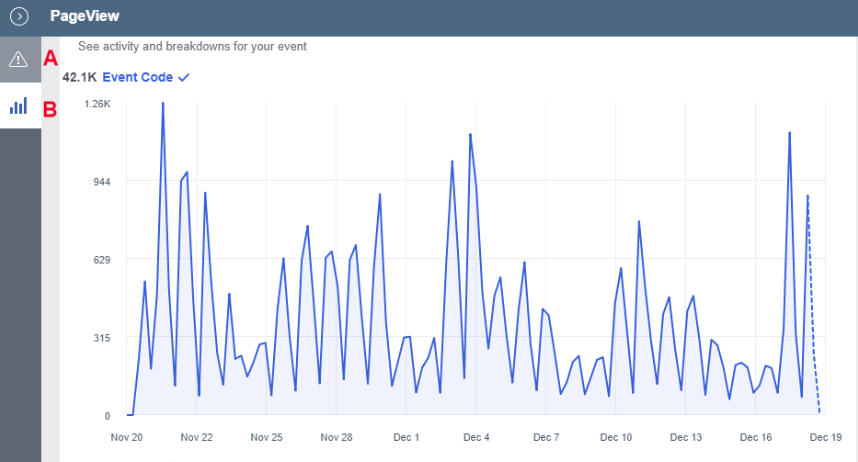
Facebook Pixel is your analytics powerhouse for ad campaigns. It goes beyond basic data, tracking user behavior on your website to enable highly focused retargeting strategies. This tool feeds this data back into your Facebook Ads Manager, allowing you to allocate your ad spend more effectively.
Key features:
Get weekly insights, advice and opinions about all things digital marketing.
Thank you for subscribing to The Content Marketer!
Creating a Facebook analytics report isn’t a monumental challenge. With a focused approach, it can be as simple as connecting the dots. The cornerstone of this process is Facebook Insights, Facebook’s native analytics tool that provides a treasure trove of data about your Facebook page.
Before you can make data-driven decisions, you need to know where to find the data. Here’s a step-by-step guide to accessing and making the most out of Facebook Insights:
1. Navigate to your Facebook page: The first step is to go to your Facebook page. You’ll see a menu on the left-hand side.
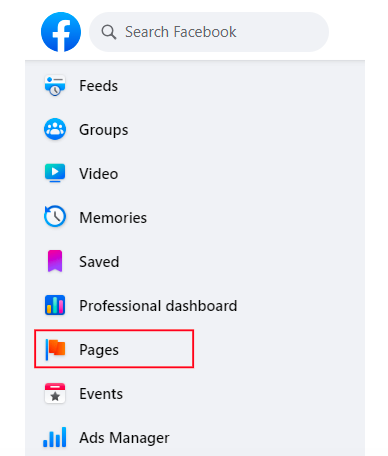
2. Find the ‘Insights’ tab: Locate and click on the “Insights” tab in that menu.
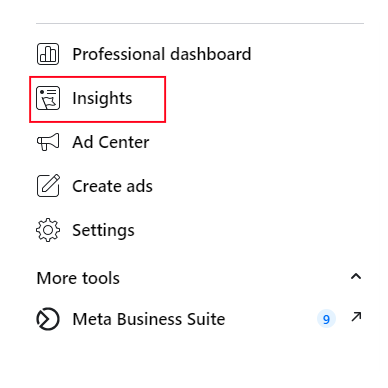
3. Explore metrics: Once you’re in, you’ll find a dashboard filled with various metrics, from page views to engagement rates. You can even filter these metrics by time periods for more specific insights.
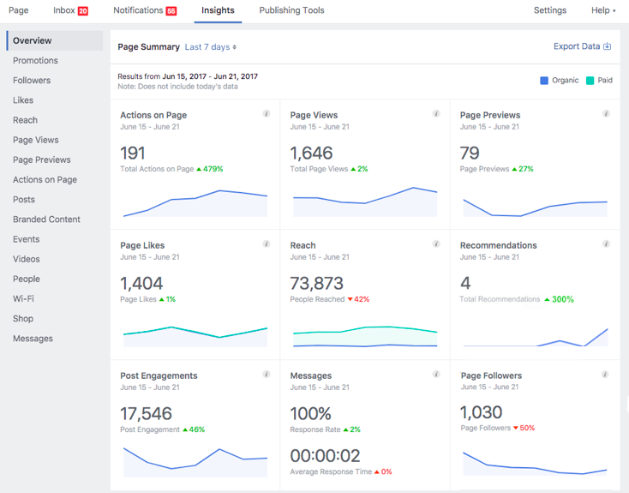
Once you’ve gathered valuable data through Facebook Insights, the next step is to share this information effectively. Whether it’s with your team or clients, here’s how to download and disseminate your insights:
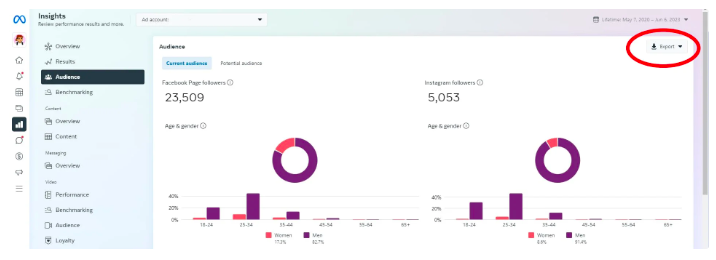
2. Import to Google Sheets: For further analysis or visualization, you can import this data into Google Sheets.
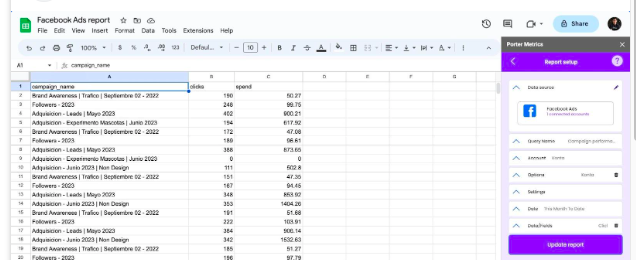
When it comes to Facebook analytics, knowing which vital statistics to keep an eye on can make all the difference. Here’s a rundown of the key metrics that can offer invaluable insights:
To get more granular with your metrics, explore Social Advertising Benchmarks, and to understand what “impression” means in the context of Facebook analytics, read The Guide to Social Media Impression Definitions. The more you understand these terms and metrics, the more accurate your understanding of your data will get.
While Facebook Insights is undeniably a robust analytics tool, it’s not the only game in town. Several other platforms offer complementary features that can enrich your Facebook analytics report. Here, we are looking at some of the most popular alternatives:
Whatagraph is a lifesaver for those who need quick yet comprehensive Facebook analytics reports. With this tool, you can generate detailed reports in under five minutes. It’s especially beneficial if you’re juggling analytics from multiple platforms, as Whatagraph seamlessly integrates data from various channels into one report.
Key features:
NapoleonCat is a robust analytics tool designed for those who want to get a leg up on their competition. It offers in-depth competitor analysis and customizable reports, allowing you to understand your market position and strategize accordingly.
Key features:
For those managing multiple social media platforms, Hootsuite offers an all-in-one dashboard that tracks your Facebook metrics and provides analytics for many other social media platforms. This makes Hootsuite an invaluable tool for those managing multiple social media accounts.
Key features:
While each of these Facebook analytics tools comes with unique capabilities, it’s crucial to remember that understanding analytics shouldn’t be limited to just one platform. The significance of grasping analytics across various social media channels is immense, a point we delve into in our article comparing TikTok and Snapchat.
But let’s not get ahead of ourselves. Before branching out, it’s vital to master the analytics of the platform you’re currently on. In today’s data-driven world, understanding Facebook analytics is not just a ‘nice-to-have,’ it’s essential.
This isn’t about a quick glance at your dashboard; it’s about deep-diving into your Facebook Insights. It’s about dissecting your engagement rates, scrutinizing your page views and fine-tuning your ad campaigns to convert raw data into actionable strategies.
So, what are you waiting for? Start analyzing your Facebook data today. Make decisions that will catapult your brand to new heights. Whether your focus is on Facebook Ads Analytics or Facebook Audience Insights, there’s no better time to act than now.